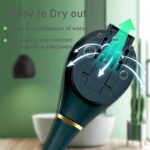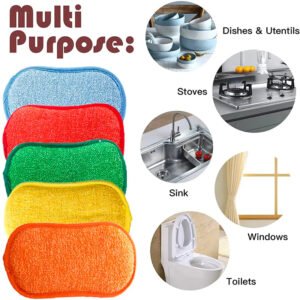Description
A cordless cleaning brush is a handheld, battery-powered cleaning tool designed to help you clean surfaces more efficiently without the restriction of cords. These brushes are versatile, easy to use, and suitable for a wide range of cleaning tasks, from scrubbing floors and tiles to cleaning kitchen appliances and bathrooms. Below is everything you need to know about cordless cleaning brushes, including their benefits, features, and how to use them:
Key Features of Cordless Cleaning Brushes:
Cordless and Rechargeable:
As the name suggests, these brushes are cord-free, providing greater freedom of movement. They are typically battery-powered and come with a rechargeable battery. Some models may offer long battery life, allowing for extensive cleaning sessions on a single charge.
Multiple Brush Heads:
Many cordless cleaning brushes come with interchangeable brush heads that are suitable for different surfaces and tasks. Common brush heads include:
Soft bristles for delicate surfaces (e.g., glass, countertops).
Stiff bristles for tougher jobs (e.g., grout, tile, and bathroom surfaces).
Scrub sponges or scouring pads for even more intensive cleaning.
Ergonomic Design:
Most cordless cleaning brushes feature ergonomic handles that are comfortable to hold for extended periods of time. The lightweight design makes them easy to maneuver, reducing strain on your hands and wrists.
Speed Settings:
Some models offer multiple speed settings, allowing you to adjust the intensity of the brush for different cleaning tasks. A high-speed setting is useful for heavy-duty cleaning, while a lower speed may be better for more delicate tasks.
Waterproof and Durable:
Many cordless cleaning brushes are designed to be water-resistant or even waterproof, making them suitable for wet cleaning tasks, such as scrubbing the shower, kitchen, or bathroom.
Compact and Portable:
These brushes are usually compact and lightweight, making them easy to store and ideal for quick touch-ups or deep cleaning. They are portable enough to use in multiple rooms or even take with you on trips.
Benefits of Using a Cordless Cleaning Brush:
Efficiency:
Cordless cleaning brushes are designed to help you clean more quickly and thoroughly compared to manual scrubbing. The rotating or oscillating motion of the brush head saves time and effort, providing a deeper clean without the need for excessive elbow grease.
Versatility:
With interchangeable brush heads and various speed settings, these brushes can be used for a wide range of cleaning tasks, including:
Bathrooms: Clean grout, tiles, bathtubs, sinks, and faucets.
Kitchen: Scrub countertops, stove grates, ovens, and even pots and pans.
Floors: Use it on hard floors, including wood, laminate, tile, and vinyl.
Car: Clean the interior or exterior of your car, including upholstery, wheels, and dashboard.
Ease of Use:
The cordless nature of the brush allows for greater freedom of movement, especially in tight spaces where a corded cleaner would be cumbersome. Its ergonomic design ensures you can clean for extended periods without discomfort.
Consistency and Control:
The rotating motion of the brush provides consistent pressure across the surface, ensuring a more even and efficient clean compared to hand scrubbing.
Suitable for People with Limited Strength:
Cordless cleaning brushes are ideal for people who may have difficulty with traditional scrubbing, such as those with arthritis or limited strength, as they require less effort to clean effectively.
Time-Saving:
Since the brush does the scrubbing for you, you can clean large areas in less time. This is especially beneficial for tasks like deep cleaning or tidying up areas that usually take a long time to scrub by hand.
Common Uses for Cordless Cleaning Brushes:
Grout Cleaning:
Grout in bathrooms and kitchens can accumulate dirt and stains over time. The stiff bristle brush head of a cordless cleaning brush is perfect for loosening and scrubbing away grime from grout lines.
Tile and Bathroom Surfaces:
Use the brush to scrub shower walls, tubs, sinks, and faucets. The brush helps remove soap scum, water stains, and mildew without having to scrub manually for long periods.
Kitchen Surfaces:
Clean countertops, stovetops, ovens, and backsplashes. The soft bristle heads are gentle on countertops, while stiffer bristles work well on areas with built-up grease or grime.
Car Cleaning:
Cordless cleaning brushes can also be used to clean car interiors, including seats, upholstery, and dashboards. The rotating brush helps scrub away dirt and stains more easily than manual cleaning.
Floor Scrubbing:
Many models come with a larger brush head designed for cleaning hard floors. Use it to scrub away dirt and grime from tile, vinyl, or hardwood floors, especially in areas that see high traffic.
Appliance Cleaning:
A cordless brush is handy for cleaning hard-to-reach spots on kitchen appliances, including the edges of fridges, microwave doors, or oven racks.
How to Use a Cordless Cleaning Brush:
Choose the Correct Brush Head:
Select the brush head that is most appropriate for your cleaning task. Stiff bristles are ideal for tough stains, while soft bristles are better for delicate surfaces.
Power On:
Turn on the brush and adjust the speed setting if necessary. Some brushes have a simple on/off switch, while others might have multiple speed settings for different tasks.
Start Scrubbing:
Hold the brush at an angle to the surface you’re cleaning and gently guide it along the area. Let the brush do the work — you don’t need to press hard.
Rinse or Wipe Surfaces:
After scrubbing, wipe the surface down with a clean, damp cloth to remove any remaining dirt or cleaning solution.
Clean the Brush:
After use, rinse or wipe down the brush head to remove any residue. Recharge the brush as needed to keep it ready for the next cleaning session.
Maintenance and Care Tips:
Recharge Regularly:
Make sure to keep the brush charged, but avoid overcharging to preserve battery life.
Clean Brush Heads After Each Use:
Rinse the brush heads under warm water to remove any debris or cleaning solution. For tougher stains, you can soak the brush head in warm, soapy water.
Store Properly:
Store the brush in a dry, cool place to prevent any damage to the motor or battery. Many models come with a stand or holder for easy storage.
Replace Brush Heads:
Depending on usage, you may need to replace the brush heads periodically, especially if the bristles start to wear down.














Reviews
There are no reviews yet.